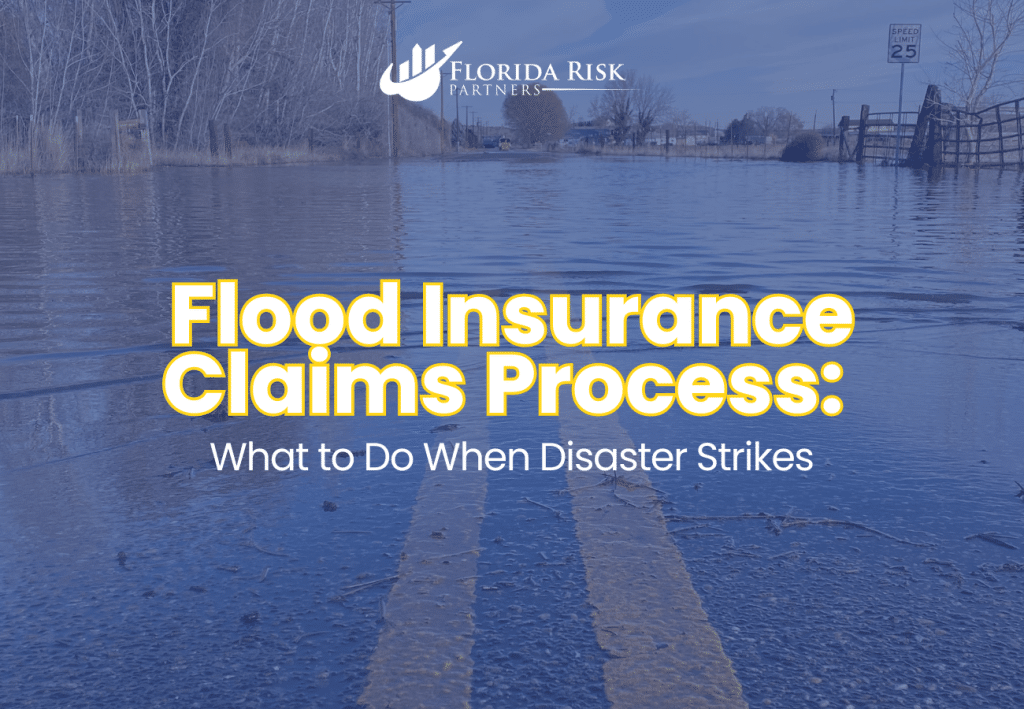-
Main Office: 1434 E. Bloomingdale Ave Valrico, FL 33596-6110
-
Phone: (888) 601-6660
-
Email: info@floridariskpartners.com

Floods can be devastating, leaving homes and businesses damaged and owners feeling overwhelmed. Whether it’s a few inches of water or several feet, the financial impact of a flood can be severe. Thankfully, if you have flood insurance, you’re better equipped to recover from the disaster. However, knowing how to navigate the flood insurance claims process is crucial for getting the compensation you need as quickly as possible.
In this post, we’ll outline the step-by-step process of filing a flood insurance claim, from documenting the damage to receiving your payout. This guide is part of our Flood Insurance 101 series, aimed at helping property owners understand the full scope of flood insurance and how it can protect them before, during, and after a disaster.
Step 1: Ensure Your Safety First
Before you begin filing a flood insurance claim, make sure it is safe to return to your property. Floods can leave behind hidden dangers, such as structural damage, electrical hazards, or contaminated water. Follow these safety tips before re-entering your home or business:
- Wait for local authorities to declare your area safe before returning.
- Wear protective gear, such as gloves and boots, to protect yourself from debris and contaminated water.
- Avoid touching electrical equipment if you’re standing in water or if there is any indication of water damage to wiring.
- Be cautious of structural damage, including weakened walls, floors, or foundations.
Once you’ve ensured your safety, you can begin the flood insurance claims process.
Step 2: Contact Your Insurance Company Immediately
After a flood, the first step in the claims process is to contact your flood insurance provider as soon as possible. Whether you have a policy through the National Flood Insurance Program (NFIP) or a private flood insurance provider, notifying them promptly is crucial. The faster you report the claim, the sooner an adjuster can be assigned to assess your property and the damage.
Here’s what to do:
- Call your insurance company or agent: Provide your policy number and contact information.
- Describe the extent of the damage: Give a general overview of the damage and any areas that are inaccessible.
- Request an advance payment if needed: If you need immediate funds for temporary repairs or lodging, ask your provider if they can offer an advance payment against your claim.
Remember, flood insurance policies typically require you to report the loss within a specific timeframe—usually within 60 days of the flood event—so don’t delay in starting the process. Learn more about flood insurance coverage here to see what your policy includes.

Step 3: Document the Damage Thoroughly
Before making any repairs, you need to document the full extent of the flood damage to your property and belongings. This documentation will serve as crucial evidence during the claims process and help your insurance adjuster accurately assess your losses.
- Take Photos and Videos: Capture clear, detailed photos and videos of all affected areas, including walls, floors, ceilings, and personal belongings. Make sure to photograph high-value items like electronics, furniture, and appliances.
- Create a Detailed Inventory: List all damaged items, noting their approximate value, make, model, and year of purchase. If you have receipts, invoices, or appraisal documents, gather them to provide additional proof of value.
- Don’t Throw Anything Away: Avoid discarding damaged items until the insurance adjuster has visited your property and completed their inspection. If you must remove items for safety reasons, set them aside in a separate area for the adjuster to inspect.
Proper documentation is key to ensuring that you receive a fair settlement. For a comprehensive breakdown of what’s covered by flood insurance, explore flood insurance coverage options here.
Step 4: Meet with the Adjuster for an Inspection
Once you’ve reported your claim and documented the damage, an insurance adjuster will be assigned to your case. The adjuster’s role is to inspect your property, assess the damage, and create a report that your insurance company will use to determine your payout.
Here’s what to expect during the adjuster’s visit:
- Schedule the Inspection: The adjuster will contact you to schedule an inspection at a time that works for both parties. Be prepared to provide access to all affected areas, including the basement, attic, or outbuildings.
- Be Present for the Inspection: It’s a good idea to be present during the inspection to point out damaged areas and answer any questions the adjuster may have.
- Review the Adjuster’s Report: After the inspection, the adjuster will create a report outlining the estimated cost of repairs and replacements. Review this report carefully to ensure that all damaged areas and items have been accounted for. If you notice any discrepancies, address them with your adjuster before moving forward.
The adjuster’s inspection is a critical step in the flood insurance claims process. If your property has suffered extensive damage, consider hiring a public adjuster to advocate on your behalf and ensure that you receive a fair settlement.
Step 5: Begin Cleanup and Mitigation Efforts
After the adjuster’s inspection, you can begin cleanup and mitigation efforts to prevent further damage to your property. While it’s important to wait until the adjuster has seen the damage before making significant repairs, you should take steps to minimize additional losses.
- Remove Standing Water: Use pumps, wet/dry vacuums, or other equipment to remove standing water from your home or business.
- Dry Out the Property: Open windows and doors to improve ventilation and use fans or dehumidifiers to dry out walls, floors, and furniture.
- Prevent Mold Growth: Mold can start growing within 24 to 48 hours after a flood. Remove wet carpets and drywall to prevent mold from spreading.
Be sure to keep all receipts and invoices for any repair work, as your insurance company may reimburse you for these expenses.

Step 6: Submit a Proof of Loss Statement
One of the most important steps in the flood insurance claims process is submitting a Proof of Loss statement. This document provides a detailed account of all the damage to your property and the amount you’re claiming. For NFIP policies, the Proof of Loss must be submitted within 60 days of the flood event, but private insurance providers may have different deadlines.
Your Proof of Loss should include:
- A complete inventory of damaged items
- Documentation of structural damage
- Repair and replacement estimates
- Supporting evidence, such as photos, videos, and receipts
The adjuster will typically assist you in completing the Proof of Loss, but it’s your responsibility to review it and ensure its accuracy. Once completed, submit the document to your insurance company for processing. Learn more about the NFIP’s claims process here.
Step 7: Receive Your Payout and Begin Repairs
Once your Proof of Loss has been reviewed and approved, you’ll receive your insurance payout based on the terms of your policy. This payment can be used to repair your home or business, replace damaged belongings, and help restore your property to its pre-flood condition.
Depending on the extent of the damage, you may receive multiple payments throughout the process. For example, you might receive an initial payment for emergency repairs and a subsequent payment for additional repairs or replacements.
Keep in mind that your payout is subject to the coverage limits and deductibles outlined in your policy. If you need additional funds beyond what your flood insurance policy covers, consider exploring disaster assistance options or applying for a SBA disaster loan.
Tips for a Smooth Flood Insurance Claims Process
Filing a flood insurance claim can be challenging, especially after experiencing a disaster. To help the process go as smoothly as possible, follow these tips:
- Communicate Regularly: Stay in touch with your insurance company and adjuster throughout the process. Prompt communication can help resolve issues quickly and keep your claim on track.
- Keep Detailed Records: Maintain a file with all correspondence, photos, receipts, and documents related to your claim. This will make it easier to track your progress and address any questions.
- Understand Your Policy: Make sure you’re familiar with the coverage limits, exclusions, and deductibles in your flood insurance policy. If you’re unsure about any details, ask your insurance agent for clarification.
- Consider Additional Coverage: If your current policy doesn’t fully cover your needs, explore options for private flood insurance or additional endorsements.
Conclusion: Be Prepared Before the Next Flood
The flood insurance claims process can be complex, but understanding the steps involved and acting quickly will help you recover more effectively after a disaster. If you haven’t already secured flood insurance, now is the time to protect your home or business.
Don’t wait until the next storm—get your flood insurance quote now here and ensure you’re ready when disaster strikes.
Call Us Or
Schedule an Appointment
Select an agent below to view our online calendars and select a day and time that works best for you or call us directly at 888-601-6660. When you use our online calendars, you will receive an email with more information.



